Abstract
To help explain a role of the Shiga toxin family in hemorrhagic colitis and hemolytic-uremic syndrome in humans, it has been hypothesized that these toxins cause direct damage to the vascular endothelium. We now report that Shiga toxin purified from Shigella dysenteriae 1 does indeed have a direct cytotoxic effect on vascular endothelial cells in cultures. Human umbilical vein endothelial cells (HUVEC) in confluent monolayers were reduced 50% by 10(-8) M Shiga toxin after a lag period of 48 to 96 h. In comparison, nonconfluent HUVEC were reduced 50% by 10(-10) M Shiga toxin within a 24-h period. These data suggest that dividing endothelial cells are more sensitive to Shiga toxin than are quiescent cells in confluent monolayers. Both confluent and nonconfluent HUVEC specifically bound 125I-Shiga toxin. However, in response to the toxin, rates of incorporation of [3H]leucine into protein were more severely reduced in nonconfluent cells than in confluent cells. Toxin inhibition of protein synthesis preceded detachment of cells from the substratum. The specific binding of 125I-Shiga toxin to human endothelial cells and the cytotoxic response were both toxin dose dependent and neutralized by anti-Shiga toxin antibody. Heat-denatured Shiga toxin was without the cytotoxic effect. In addition, the complete culture system contained less than 0.1 ng of bacterial endotoxin per ml, as measured by the Limulus amoebocyte lysate test.
Full text
PDF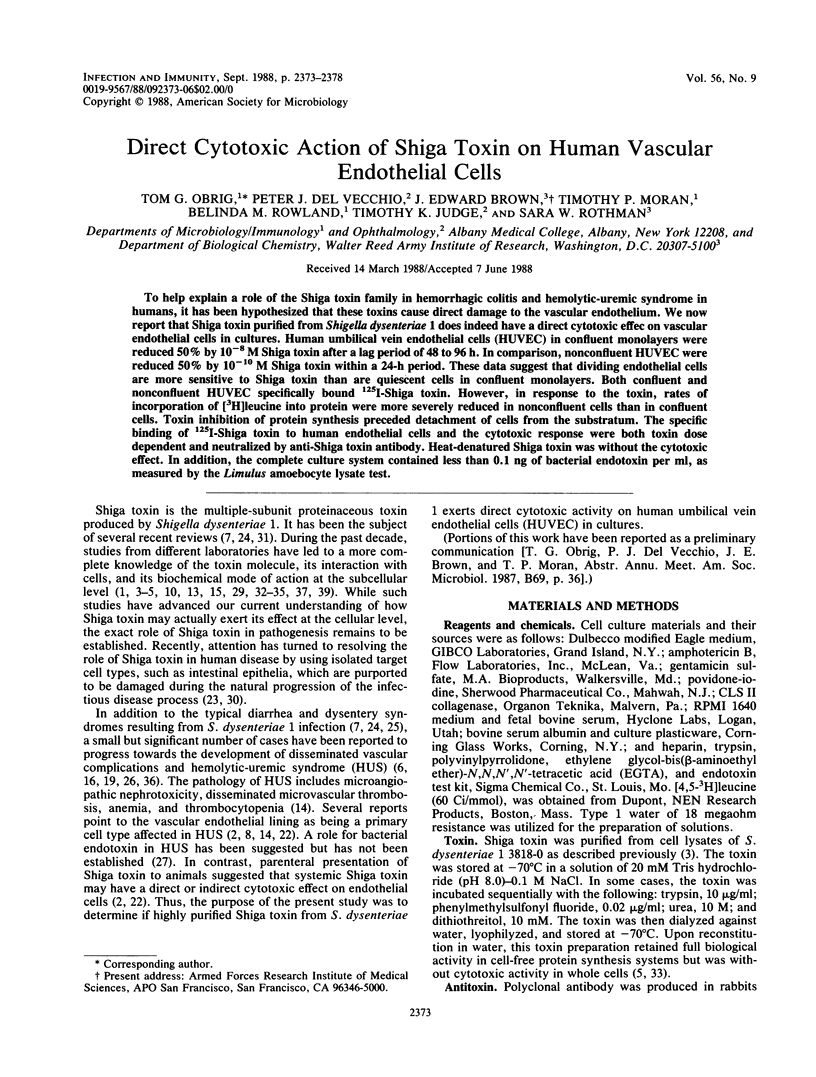
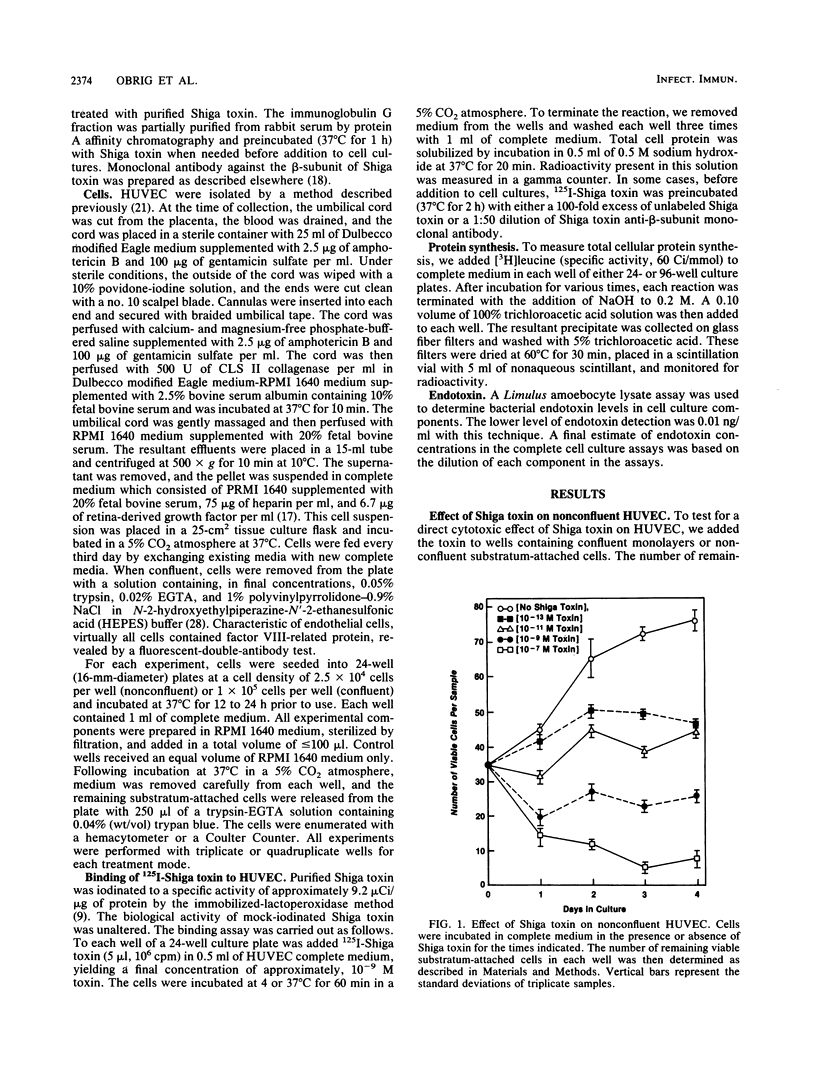
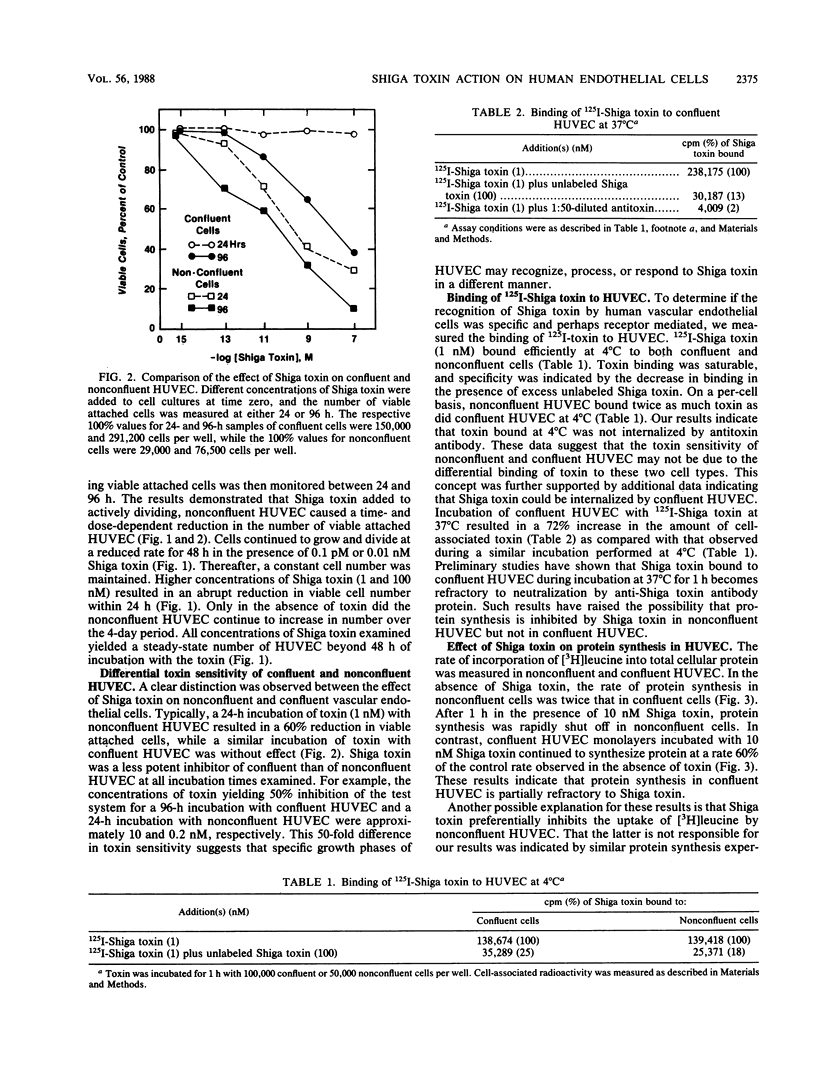
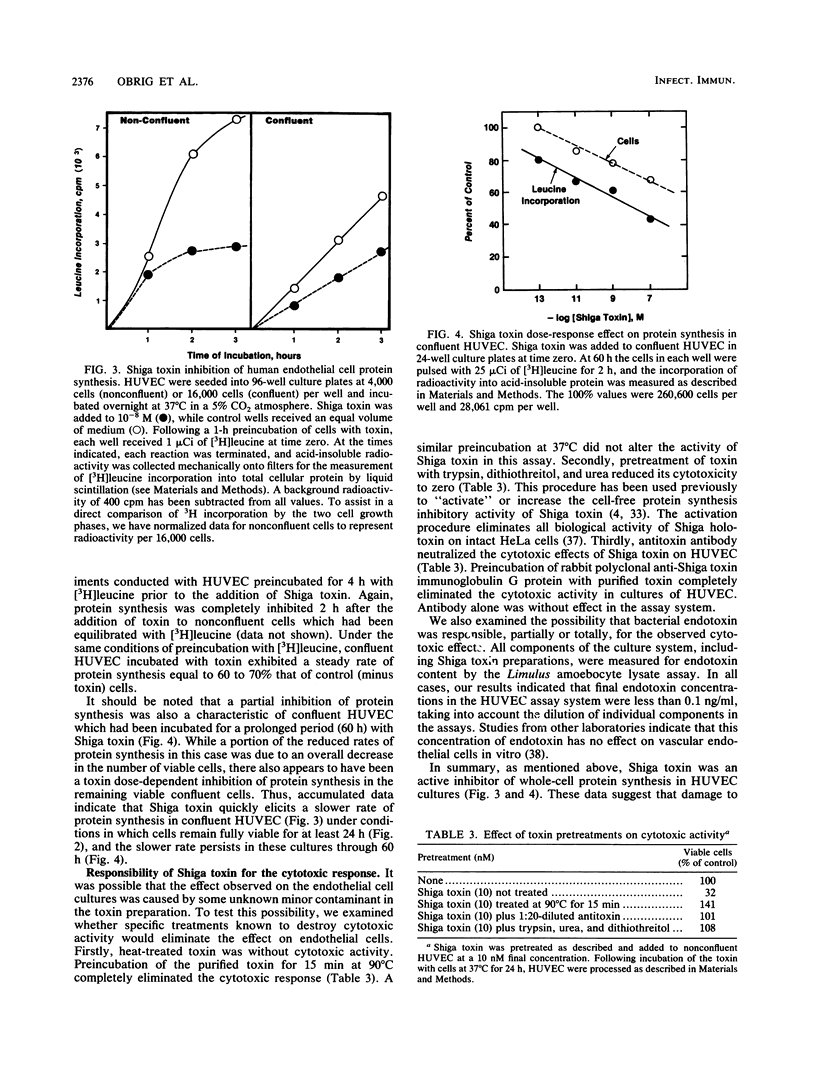
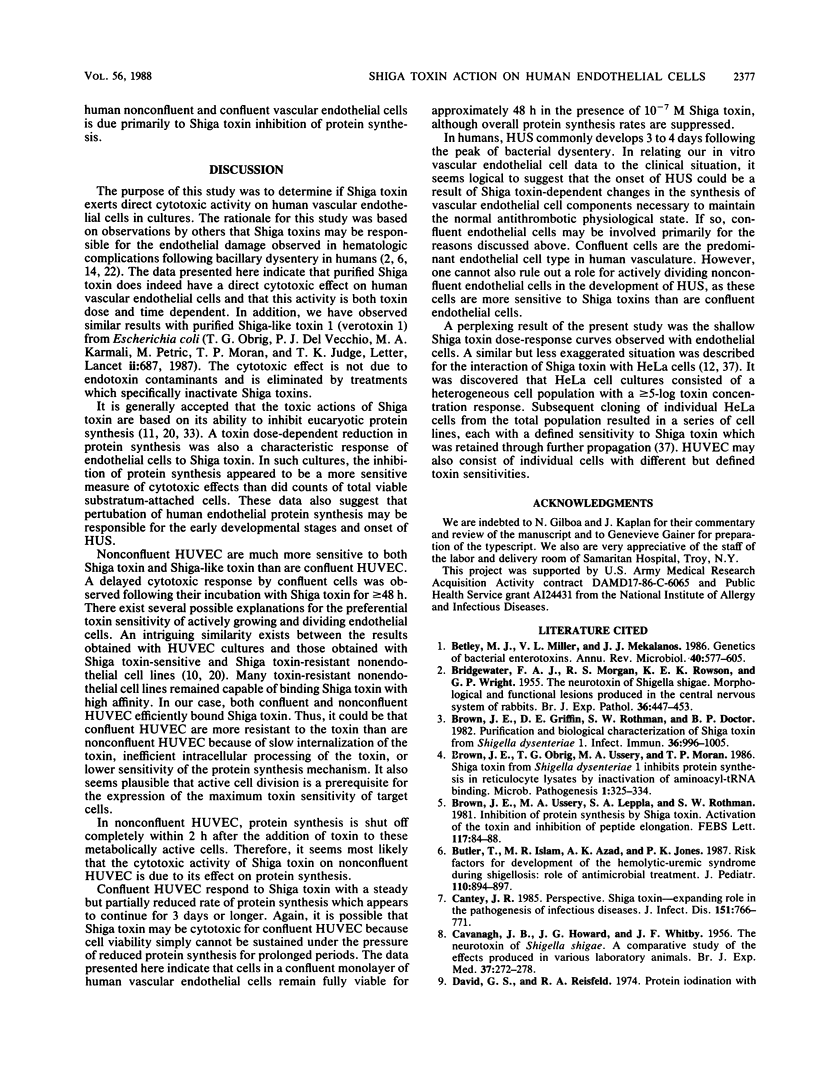
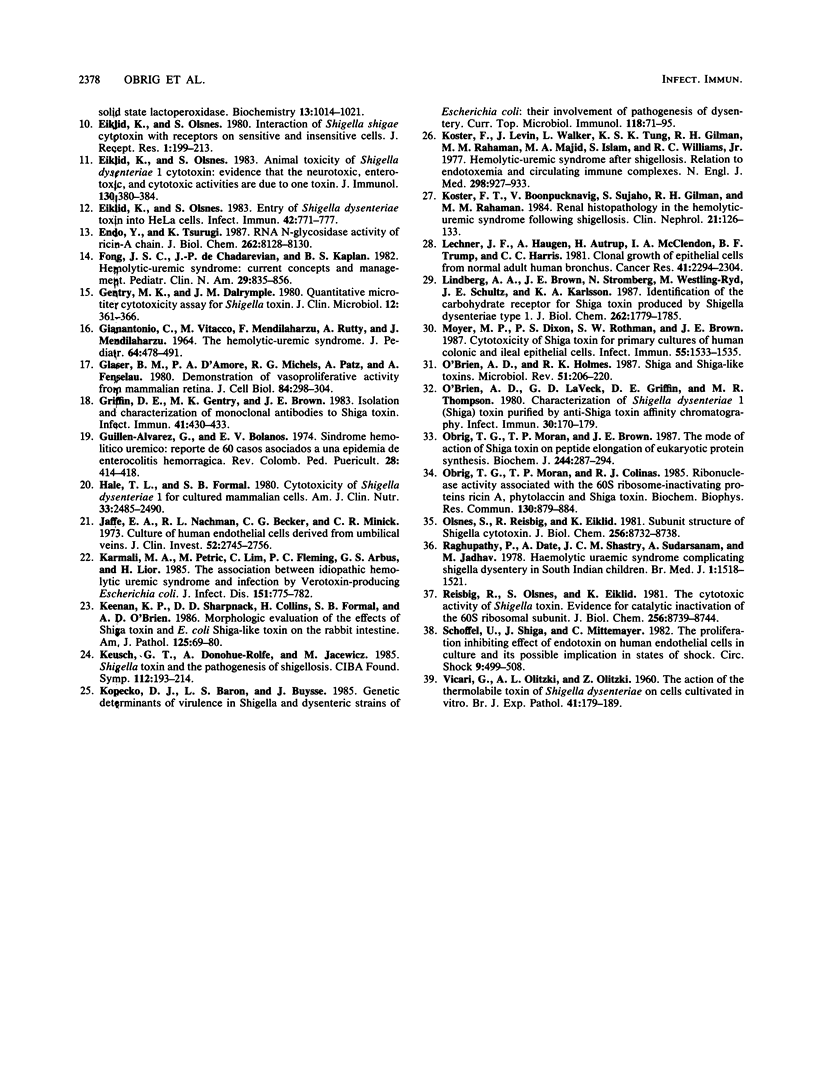
Selected References
These references are in PubMed. This may not be the complete list of references from this article.
- BRIDGWATER F. A., MORGAN R. S., ROWSON K. E., WRIGHT G. P. The neurotoxin of Shigella shigae: morphological and functional lesions produced in the central nervous system of rabbits. Br J Exp Pathol. 1955 Oct;36(5):447–453. [PMC free article] [PubMed] [Google Scholar]
- Betley M. J., Miller V. L., Mekalanos J. J. Genetics of bacterial enterotoxins. Annu Rev Microbiol. 1986;40:577–605. doi: 10.1146/annurev.mi.40.100186.003045. [DOI] [PubMed] [Google Scholar]
- Brown J. E., Griffin D. E., Rothman S. W., Doctor B. P. Purification and biological characterization of shiga toxin from Shigella dysenteriae 1. Infect Immun. 1982 Jun;36(3):996–1005. doi: 10.1128/iai.36.3.996-1005.1982. [DOI] [PMC free article] [PubMed] [Google Scholar]
- Brown J. E., Obrig T. G., Ussery M. A., Moran T. P. Shiga toxin from Shigella dysenteriae 1 inhibits protein synthesis in reticulocyte lysates by inactivation of aminoacyl-tRNA binding. Microb Pathog. 1986 Aug;1(4):325–334. doi: 10.1016/0882-4010(86)90065-3. [DOI] [PubMed] [Google Scholar]
- Brown J. E., Ussery M. A., Leppla S. H., Rothman S. W. Inhibition of protein synthesis by Shiga toxin: activation of the toxin and inhibition of peptide elongation. FEBS Lett. 1980 Aug 11;117(1):84–88. doi: 10.1016/0014-5793(80)80918-5. [DOI] [PubMed] [Google Scholar]
- Butler T., Islam M. R., Azad M. A., Jones P. K. Risk factors for development of hemolytic uremic syndrome during shigellosis. J Pediatr. 1987 Jun;110(6):894–897. doi: 10.1016/s0022-3476(87)80405-5. [DOI] [PubMed] [Google Scholar]
- CAVANAGH J. B., HOWARD J. G., WHITBY J. L. The neurotoxin of Shigella shigae; a comparative study of the effects produced in various laboratory animals. Br J Exp Pathol. 1956 Jun;37(3):272–278. [PMC free article] [PubMed] [Google Scholar]
- Cantey J. R. Shiga toxin--an expanding role in the pathogenesis of infectious diseases. J Infect Dis. 1985 May;151(5):766–771. doi: 10.1093/infdis/151.5.766. [DOI] [PubMed] [Google Scholar]
- Eiklid K., Olsnes S. Animal toxicity of Shigella dysenteriae cytotoxin: evidence that the neurotoxic, enterotoxic, and cytotoxic activities are due to one toxin. J Immunol. 1983 Jan;130(1):380–384. [PubMed] [Google Scholar]
- Eiklid K., Olsnes S. Entry of Shigella dysenteriae toxin into HeLa cells. Infect Immun. 1983 Nov;42(2):771–777. doi: 10.1128/iai.42.2.771-777.1983. [DOI] [PMC free article] [PubMed] [Google Scholar]
- Eiklid K., Olsnes S. Interaction of Shigella shigae cytotoxin with receptors on sensitive and insensitive cells. J Recept Res. 1980;1(2):199–213. doi: 10.3109/10799898009044098. [DOI] [PubMed] [Google Scholar]
- Endo Y., Tsurugi K. RNA N-glycosidase activity of ricin A-chain. Mechanism of action of the toxic lectin ricin on eukaryotic ribosomes. J Biol Chem. 1987 Jun 15;262(17):8128–8130. [PubMed] [Google Scholar]
- Fong J. S., de Chadarevian J. P., Kaplan B. S. Hemolytic-uremic syndrome. Current concepts and management. Pediatr Clin North Am. 1982 Aug;29(4):835–856. doi: 10.1016/s0031-3955(16)34216-x. [DOI] [PubMed] [Google Scholar]
- GIANANTONIO C., VITACCO M., MENDILAHARZU F., RUTTY A., MENDILAHARZU J. THE HEMOLYTIC-UREMIC SYNDROME. J Pediatr. 1964 Apr;64:478–491. doi: 10.1016/s0022-3476(64)80337-1. [DOI] [PubMed] [Google Scholar]
- Gentry M. K., Dalrymple J. M. Quantitative microtiter cytotoxicity assay for Shigella toxin. J Clin Microbiol. 1980 Sep;12(3):361–366. doi: 10.1128/jcm.12.3.361-366.1980. [DOI] [PMC free article] [PubMed] [Google Scholar]
- Glaser B. M., D'Amore P. A., Michels R. G., Patz A., Fenselau A. Demonstration of vasoproliferative activity from mammalian retina. J Cell Biol. 1980 Feb;84(2):298–304. doi: 10.1083/jcb.84.2.298. [DOI] [PMC free article] [PubMed] [Google Scholar]
- Hale T. L., Formal S. B. Cytotoxicity of Shigella dysenteriae 1 for cultured mammalian cells. Am J Clin Nutr. 1980 Nov;33(11 Suppl):2485–2490. doi: 10.1093/ajcn/33.11.2485. [DOI] [PubMed] [Google Scholar]
- Jaffe E. A., Nachman R. L., Becker C. G., Minick C. R. Culture of human endothelial cells derived from umbilical veins. Identification by morphologic and immunologic criteria. J Clin Invest. 1973 Nov;52(11):2745–2756. doi: 10.1172/JCI107470. [DOI] [PMC free article] [PubMed] [Google Scholar]
- Karmali M. A., Petric M., Lim C., Fleming P. C., Arbus G. S., Lior H. The association between idiopathic hemolytic uremic syndrome and infection by verotoxin-producing Escherichia coli. J Infect Dis. 1985 May;151(5):775–782. doi: 10.1093/infdis/151.5.775. [DOI] [PubMed] [Google Scholar]
- Keenan K. P., Sharpnack D. D., Collins H., Formal S. B., O'Brien A. D. Morphologic evaluation of the effects of Shiga toxin and E coli Shiga-like toxin on the rabbit intestine. Am J Pathol. 1986 Oct;125(1):69–80. [PMC free article] [PubMed] [Google Scholar]
- Keusch G. T., Donohue-Rolfe A., Jacewicz M. Shigella toxin and the pathogenesis of shigellosis. Ciba Found Symp. 1985;112:193–214. doi: 10.1002/9780470720936.ch11. [DOI] [PubMed] [Google Scholar]
- Kopecko D. J., Baron L. S., Buysse J. Genetic determinants of virulence in Shigella and dysenteric strains of Escherichia coli: their involvement in the pathogenesis of dysentery. Curr Top Microbiol Immunol. 1985;118:71–95. doi: 10.1007/978-3-642-70586-1_5. [DOI] [PubMed] [Google Scholar]
- Koster F. T., Boonpucknavig V., Sujaho S., Gilman R. H., Rahaman M. M. Renal histopathology in the hemolytic-uremic syndrome following shigellosis. Clin Nephrol. 1984 Feb;21(2):126–133. [PubMed] [Google Scholar]
- Koster F., Levin J., Walker L., Tung K. S., Gilman R. H., Rahaman M. M., Majid M. A., Islam S., Williams R. C., Jr Hemolytic-uremic syndrome after shigellosis. Relation to endotoxemia and circulating immune complexes. N Engl J Med. 1978 Apr 27;298(17):927–933. doi: 10.1056/NEJM197804272981702. [DOI] [PubMed] [Google Scholar]
- Lechner J. F., Haugen A., Autrup H., McClendon I. A., Trump B. F., Harris C. C. Clonal growth of epithelial cells from normal adult human bronchus. Cancer Res. 1981 Jun;41(6):2294–2304. [PubMed] [Google Scholar]
- Lindberg A. A., Brown J. E., Strömberg N., Westling-Ryd M., Schultz J. E., Karlsson K. A. Identification of the carbohydrate receptor for Shiga toxin produced by Shigella dysenteriae type 1. J Biol Chem. 1987 Feb 5;262(4):1779–1785. [PubMed] [Google Scholar]
- Moyer M. P., Dixon P. S., Rothman S. W., Brown J. E. Cytotoxicity of Shiga toxin for primary cultures of human colonic and ileal epithelial cells. Infect Immun. 1987 Jun;55(6):1533–1535. doi: 10.1128/iai.55.6.1533-1535.1987. [DOI] [PMC free article] [PubMed] [Google Scholar]
- O'Brien A. D., Holmes R. K. Shiga and Shiga-like toxins. Microbiol Rev. 1987 Jun;51(2):206–220. doi: 10.1128/mr.51.2.206-220.1987. [DOI] [PMC free article] [PubMed] [Google Scholar]
- O'Brien A. D., LaVeck G. D., Griffin D. E., Thompson M. R. Characterization of Shigella dysenteriae 1 (Shiga) toxin purified by anti-Shiga toxin affinity chromatography. Infect Immun. 1980 Oct;30(1):170–179. doi: 10.1128/iai.30.1.170-179.1980. [DOI] [PMC free article] [PubMed] [Google Scholar]
- Obrig T. G., Moran T. P., Brown J. E. The mode of action of Shiga toxin on peptide elongation of eukaryotic protein synthesis. Biochem J. 1987 Jun 1;244(2):287–294. doi: 10.1042/bj2440287. [DOI] [PMC free article] [PubMed] [Google Scholar]
- Obrig T. G., Moran T. P., Colinas R. J. Ribonuclease activity associated with the 60S ribosome-inactivating proteins ricin A, phytolaccin and Shiga toxin. Biochem Biophys Res Commun. 1985 Jul 31;130(2):879–884. doi: 10.1016/0006-291x(85)90498-x. [DOI] [PubMed] [Google Scholar]
- Olsnes S., Reisbig R., Eiklid K. Subunit structure of Shigella cytotoxin. J Biol Chem. 1981 Aug 25;256(16):8732–8738. [PubMed] [Google Scholar]
- Raghupathy P., Date A., Shastry J. C., Sudarsanam A., Jadhav M. Haemolytic-uraemic syndrome complicating shigella dystentery in south Indian children. Br Med J. 1978 Jun 10;1(6126):1518–1521. doi: 10.1136/bmj.1.6126.1518. [DOI] [PMC free article] [PubMed] [Google Scholar]
- Reisbig R., Olsnes S., Eiklid K. The cytotoxic activity of Shigella toxin. Evidence for catalytic inactivation of the 60 S ribosomal subunit. J Biol Chem. 1981 Aug 25;256(16):8739–8744. [PubMed] [Google Scholar]
- Schöffel U., Shiga J., Mittermayer C. The proliferation-inhibiting effect of endotoxin on human endothelial cells in culture and its possible implication in states of shock. Circ Shock. 1982;9(5):499–508. [PubMed] [Google Scholar]
- VICARI G., OLITZKI A. L., OLITZKI Z. The action of the thermolabile toxin of Shigella dysenteriae on cells cultivated in vitro. Br J Exp Pathol. 1960 Apr;41:179–189. [PMC free article] [PubMed] [Google Scholar]


